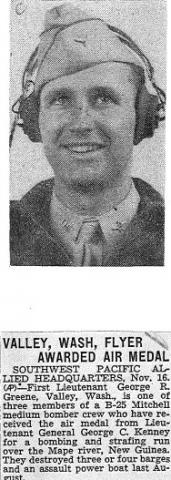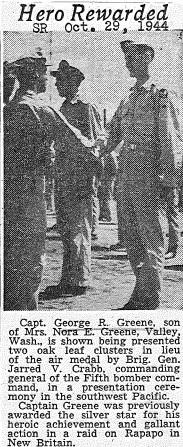George Rodrick Greene
Pre-WSC Background
George Rodrick Greene was born June 24, 1920, in Sunnyside, Washington, to George, Sr., and Nora Wagner Greene. George, Sr., and Nora met in North Carolina and married on September 6, 1906. By the time George, Sr. registered for the draft during World War I, he and his family were living in Lancaster, Washington, in Whitman County, where he worked as a farmer to support his growing family.
Greene had three older brothers, Orville, O.T. (Tommy), and O.V. McIntyre (Mack), one older sister, Violet, and one younger sister, Rosemary. He and his family lived on the Yakima Indian Reservation for a time during his childhood. The family relocated to Spokane by 1935, where George, Sr. worked as an operator on a rented farm. Greene graduated from Lewis and Clark High School in Spokane. During his high school years, he also worked as an operator at a gas station.
WSC Experience
Greene attended Washington State College (WSC) during the 1941 to 1942 academic year as a mechanical engineering major. George, Sr. had a seventh-grade education, while Nora Greene went to school until her sophomore year in high school. Greene’s attendance at WSC was likely a source of pride for his family. None of his siblings graduated from college.
Wartime Service and Death
Greene registered for the draft on July 1, 1941, at which time he noted his employer to be Northwest Magnesite Company in Chewelah, Washington. The Northwest Magnesite Company operated a plant for processing magnesite ore for the steel industry. Following the United States’ entrance into World War II after the attack at Pearl Harbor on December 7, 1941, Greene enlisted in the Army Air Corps as an Aviation Cadet on January 21, 1942. He was sent to Williams Field, in Chandler, Arizona, where he was commissioned as a second lieutenant and received his silver wings in October 1942.
Greene was assigned to the 3rd Bombardment Group, which was originally formed as a reconnaissance group in 1919 and spent three years patrolling the Mexican border. It became a bombardment group in 1939, providing training to crews formed during the expansion of the Air Corps over the next two years. The group was sent to Australia after the U.S. entered the war, and they began operations with its B-25s in early April 1942. Early operations included targets on New Guinea, where the group was successful in helping to stop the Japanese advance towards Port Moresby. The group also flew reconnaissance missions, flying more than 120 recon sorties in May 1942.
The 3rd Bombardment Group operated a mix of aircraft, with the number of B-25s slowly rising until two squadrons were operating the planes by the end of the summer of 1942. The group moved to New Guinea in early 1943, taking part in the Allied advance along the north coast of the island. In March 1943, the group fought in the Battle of the Bismarck Sea. Greene joined them in May 1943 as a member of the 13th Squadron, 3rd Bombardment Group; this group was known as the “Grim Reapers.” Greene received the air medal from Lieutenant General George C. Kenney for a bombing and strafing run over the Mape river in New Guinea in August 1943; his bomber crew destroyed “three or four barges and an assault powerboat…”
Beginning on October 12, 1943, as part of Operation Cartwheel, the U.S. Fifth Air Force, the Royal Australian Air Force, and the Royal New Zealand Air Force, under the direction of the Allied air commander in the Southwest Pacific Area, General George Kenney, launched a sustained campaign of bombing against the airfields and port of Rabaul on the island of New Britain. Prior to mid-September of 1943, Rabaul had been beyond the effective range of modified B-25s. Once Lae and the Markham Valley fell into Allied hands, the Fifth Air Force established forward staging bases that put the B-25s much closer to the important Japanese supply base. General MacArthur wanted to avoid a costly battle to capture Rabaul, so the Fifth Air Force mounted this air campaign against the airfields and supply bases as well as Japanese ships in the harbor.
Greene, now a First Lieutenant, was part of the 3rd Attack Group, led by Major John P. Henebry, flying B-25s over Rapopo on October 12, 1943. The “low-flying B-25 pilots opened fire on the antiaircraft guns, then swooped over the rows of parked airplanes and covered them with tiny but deadly parachute bombs…the men of the 3rd estimated that they had destroyed between 15 and 25 airplanes on the ground while group gunners claimed three air-to-air kills.” B-25s resumed attacking on October 18, despite bad weather, and sank three Japanese ships against fierce enemy fighter attacks.
For his actions over Rapopo, Greene received the Silver Star and was later promoted to captain. The 3rd Attack Group began flying A-20s to attacking shipping and a floatplane base on Kavieng in February 1944, followed by their participation in the largest Fifth Air Force raid up until that point in an attack on Hollandia on April 3, 1944. In an October 27, 1944 article in the Spokane Chronicle, Captain Greene was noted to have flown 110 strike missions against enemy targets in western New Guinea. In an attack on Kronprinz Harbor and Hansa Bay, New Guinea, he was credited with scoring direct hits on two armed enemy vessels, sinking one and “probably destroying the other.” He was awarded two oak leaf clusters in lieu of an air medal by Brigadier General Jarred V. Crabb, commanding general of the Fifth bomber command, in a presentation ceremony in the southwest Pacific. Greene received a promotion to major, which was announced in January 1945.
Major George R. Greene was killed while participating in a bomb experimental test in the Philippines on February 17, 1945. After spending much of his time overseas in New Guinea, Greene was transferred to the Philippines where he was commanding officer of his group. His plane “burst into flames” and crash-landed in the water near Alibatan Island after making a “daring low-level pass over the designated target. A rescue squadron immediately dispatched to the scene, failed to recover the body.”
Postwar Legacy
Greene’s military career charted an amazing trajectory, moving from an enlisted soldier to the rank of major. Given his humble beginnings as the son of a farmer with a seventh-grade education, his story touched E.O. Holland, President Emeritus of WSC, who wrote to Greene’s parents, “His record in the war was a magnificent one…The fact, too, that he had won the distinguished flying cross and had been awarded the air medal with seven oak leaf clusters and the silver star is evidence that he was most successful in his activities.” For Greene’s mother, his loss was devastating. She wrote to E.O. Holland, “We sure do grieve for him. He was such a wonderful young man…We do have 3 sons left. But there can never be any one to fill his place in our hearts.” Two years later, Mrs. Greene wrote, “We can never get over his death. Because we never got to see him from the day he left for training. He just did too much. It was too strenuous on him. You can see by papers he did so much that other might live. Too much can’t be said of his heroism.”
Greene is memorialized at the Manila American Cemetery, Manila, Philippines as well as the WSU Veterans Memorial. His awards for his military service include the Silver Star, the Distinguished Flying Cross with Oak Leaf Cluster, Air Medal with Three Oak Leaf Clusters, and the Purple Heart.



